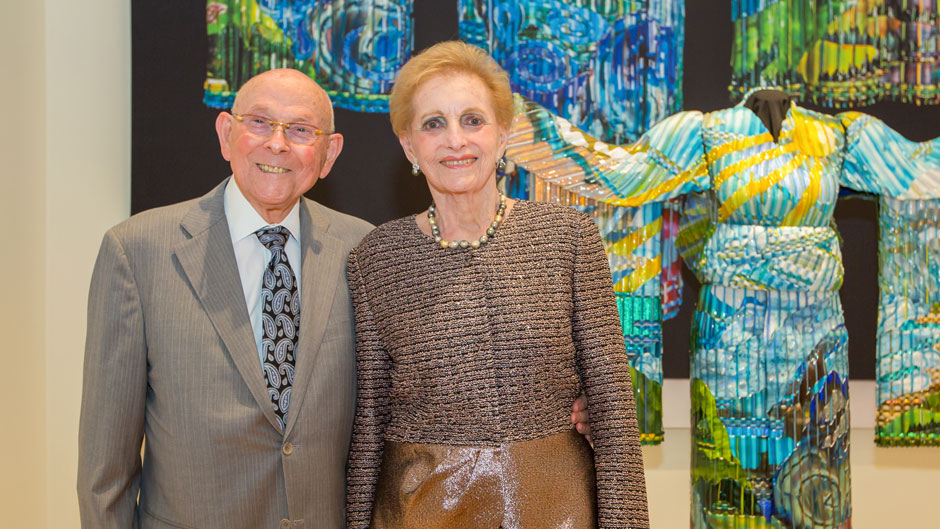To listen to Robert Werner recount it, he and his late wife, Florence, were complete novices when they purchased their first piece of art glass.
It was in the early 1990s, during a whistle-stop business trip in Europe.
“It was going to be a two-week trip, and you could bring your spouse or significant other,” Werner recalled. “Halfway through, we ended up stopping in Venice for some R and R, where we did a walking tour. And we ended up, as we always do on a tour, at a place to buy things.”
That place was a showroom for art glass from Venetian master makers, whose workshops are centered on the island of Murano in the Venetian lagoon. Werner was captivated by the figure of a woman by the late Loredano Rosin, who used a technique first perfected by Murano glassmakers in the 15th century. Called “calcedonio,” the technique imparts streaks of rich color to the glass, making it look like marble, and is unique to Murano.
“It was a very unusual figure,” Werner said. “I liked it because it was a beautiful piece, and because [the technique] has a history that is unique. It’s probably the most historic piece in our collection. It was our first piece, and that’s how we got started.”
Three decades later, and the Werners’ collection is now composed of 270 pieces of late 20th and early 21st century contemporary art glass, from established masters to emerging talents. Starting as self-confessed novices, the Werners immersed themselves in the field of art glass collecting, acquiring considerable knowledge along the way by engaging with the artists as well as specialist curators and fellow collectors. “We learned a lot about glass as we went on, and we got smarter” about acquisitions, Werner noted.
Before Florence’s death in 2020 at age 85, the Werners committed to leaving the collection to the Lowe Art Museum, intending to move the pieces for display and long-term preservation as space became available.
According to Werner, they chose the Lowe for their collection in part because “we had been living in Miami for a long time and felt that we’d like to leave it to a hometown group.” The Werners count Jill Deupi, chief curator of the Lowe and director of Beaux Arts, as a good friend. “She’s outstanding,” said Werner of Deupi. “She has vision and skill that are amazing.”
In 2021, Werner made a testamentary gift of $1 million on Florence and his behalf to support the collection’s conservation, storage, and display at the Lowe. “We recognized that when you give something to a museum, in addition to the artwork, you need to consider providing funds to take care of it,” he said.
The Werners’ financial commitment is part of the University of Miami’s Ever Brighter: The Campaign for Our Next Century. The most ambitious in the University’s history, the $2.5 billion campaign is set to conclude in 2025, when the University will celebrate its centennial.
“The Werners’ incredible gift to the Lowe is truly transformative—for the Lowe, for the University of Miami, for our community, and for the wider world of contemporary glass,” said Deupi. “Building on the incredible foundation laid by Myrna and Sheldon Palley and other supporters of our Palley Pavilion, this donation will enable us to explore the history of the Studio Glass movement in even greater detail through key masters and pivotal masterworks.”
In 2018, the Werners’ collection was celebrated at the Lowe exhibition titled “Dialogues: Studio Glass from the Florence and Robert Werner Collection.” Sixty pieces from their collection were showcased, most notably the striking “Summer Zenith Kimono,” by Eric Markow and Thom Norris. One of only four made, each representing one of the four seasons, the kimono is the result of the artists’ devising a technique for weaving strips of glass into an intricately designed and richly textured life-sized garment.
Werner, whose love of Japanese art and culture dates from his army service in Tokyo during the Korean War, first saw the kimono with his wife at an art glass show. “It blew us away,” he declared. “But it was much more expensive than anything we had bought before, and it was very big. We didn’t know whether it would fit into our apartment.”
The Werners’ children and grandchildren eventually convinced them to purchase the kimono. With the help of an interior designer friend, they worked out how to rearrange their furniture to accommodate it, and it arrived packed in 18 specially designed cushioned boxes.
For the 2018 Lowe exhibition, the Werners brought the artists to South Florida to disassemble and pack up the kimono, take it to the Lowe, and install it. They had already intended to give a few of the pieces from the exhibition to the museum and, Werner explained, “Florence and I said to ourselves, ‘what are we going to do with the kimono? Every time it is taken apart, packed, moved, and unpacked, something could break.’ We decided to loan it to the Lowe until we give it to them. It’s still there, and we are thrilled that it is such a hit with the community.”
The kimono exemplifies the Werners’ approach to collecting. “Florence was always attracted to the beautiful pieces, while I was more inclined to the technical side of glass art. We always found common ground and that was how we bought the pieces that we have today,” pointed out Werner, a materials engineer by profession.
“Florence and I had a fabulous life together. For over 25 years we traveled the world together on amazing trips buying art glass. We have collected so many pieces over the years, it’s as if we are shepherds taking care of a flock,” he added. “These pieces belong to the community for all to be appreciated and enjoyed. My wife and I are truly leaving a legacy, and we are delighted to have the collection in the hands of the Lowe Art Museum.”

